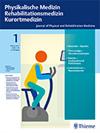健康成年人与年龄相关的握力和股四头肌肌力比、跌倒风险和平衡
IF 0.5
4区 医学
Q4 REHABILITATION
Physikalische Medizin Rehabilitationsmedizin Kurortmedizin
Pub Date : 2023-03-20
DOI:10.1055/a-2121-3509
引用次数: 0
摘要
摘要目的本研究的目的是检验健康成年人与年龄相关的握力与股四头肌力量比、跌倒风险和平衡之间的关系,并展示这些参数之间的相互作用。方法92名参与者被分为6组,分别为18-29、30-39、40-49、50-59、60-69、70和老年人。评估跌倒风险、平衡、握力和股四头肌力量。研究了握力/股四头肌力量比(G/Q)与跌倒和平衡风险之间的相关性。结果各年龄组的G/Q与平衡或跌倒风险无显著差异。此外,在60岁及以上的人群中,它与握力、股四头肌力量、平衡和跌倒风险之间存在中度和显著的相关性。结论用不同年龄组的握力与股四头肌力量的比值来预测平衡和跌倒风险是不够的。在未来的研究中,可以使用各种测试组合以及不同的参数,如下肢耐力和灵活性,来评估生理跌倒风险和平衡。本文章由计算机程序翻译,如有差异,请以英文原文为准。
Age-Related Hand Grip and Quadriceps Muscle Strength Ratio, Fall Risk, and Balance in Healthy Adults
Abstract Objectives The aim of this study is to examine the relationship between age-related hand grip and quadriceps muscle strength ratio, fall risk and balance in healthy adults, and also to show the interaction between these parameters. Methods 92 participants were examined in 6 groups as 18–29, 30–39, 40–49, 50–59, 60–69, 70 and older individuals. Fall risk, balance, grip strength and quadriceps muscle strength were evaluated. The correlation between the grip/quadriceps strength ratio (G/Q) and the risk of falling and balance was examined. Results There was no significant difference between G/Q and balance or fall risk in all age groups. In addition, it showed moderate and significant correlations with grip and quadriceps muscle strength, balance, and fall risk in groups aged 60 years and older. Conclusion It is not sufficient to use the ratio of hand grip strength and quadriceps muscle strength in different age groups to predict balance and fall risk. Various test combinations as well as different parameters such as lower extremity endurance and flexibility can be used to evaluate physiological fall risk and balance in the future studies.
求助全文
通过发布文献求助,成功后即可免费获取论文全文。
去求助
来源期刊
CiteScore
1.10
自引率
25.00%
发文量
70
审稿时长
3 months
期刊介绍:
The Journal of Physical and Rehabilitation Medicine offers you the most up-to-date information about physical medicine in clinic and practice, as well as interdisciplinary information about rehabilitation medicine and spa medicine.
Publishing 6 issues a year, the journal includes selected original research articles and reviews as well as guidelines and summaries of the latest research findings. The journal also publishes society news and editorial material. “Online first” publication ensures rapid dissemination of knowledge.

 求助内容:
求助内容: 应助结果提醒方式:
应助结果提醒方式:


